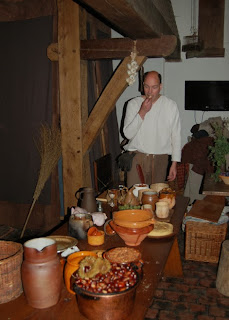What do entrails have to do with feast and food? It is a spectacle food or 'entremet', set between the normal courses of a medieval feast. It was made to awe or shock those sitting at the table, like pigeons flying from a pie, a gilded pigs head, or in this case a bunch of fried 'entrails'. The fun is of course that it only resembles entrails from the outside. The recipe is called 'Trayne Roste' and is given in Harleian MS 4016 - and translated in the 15th century medieval cookbook 'Take a thousand eggs or more' by Cindy Renfrow (ISBN 978-0962859847). Bram made this delightful dish at Castle Loevestein in Poederoijen, the Netherlands last year using the medieval castle kitchen and roast spit.
A double roast in the kitchen of castle Loevestein: two chickens at the top spit, and the 'trayn roast' at the bottom.
Bram holds a skillet with dough to pour over the 'Trayn roast'.
"Take dates and figs and cut them in a penny's breath; And then take great raisins and blanched almonds, and prick them through with a needle into a thread of a man's length, and one of one fruit and another of another fruit, and then bind the thread with the fruit. About a round spit, along the spit in manner of a haslet: and then take a quart of wine or ale, and fine flour. And make batter thereof, and cast thereto powdered ginger, sugar and saffron, powder of cloves, salt. And make the batter not fully running, and neither standing, but in the mean, that it may cleave, and then roast the train about the fire, in the spit. And then cast the batter on the train as he turns about the fire, so long till the fruit is hidden in the batter, as thou cast the batter theron, hold a vessel underneath, for spilling of the batter. And when it is roasted well, it will seem a haslet, And then take it up from the spit all whole. And cut it in fair pieces of a span's length. And of it a piece or two in a dish all hot."
While the translation in 'Take a thousand eggs or more' uses shorter strings and frying oil, we did have a medieval spit at hand in Castle Loevestein and could follow the original instructions to roast the train. For the rest we stayed with the recipe as provided in the cookbook. As a variation dried apples, apricots or walnuts can be used in addition to the fruits used here.
- a piece of heavy duty string, 1 to 2 metres long
- 1/4 cup of sliced almonds, soaked in warm water and drained
- 18 dried black figs, cut in half
- 200 gram pitted dates, cut in half
- 1/2 cup seedless raisins
For the batter:
- 200 ml beer (or ale or wine)
- 1 1/3 cup of flour
- pinch saffron
- 1 teaspoon of sugar
- 1/4 teaspoon clove powder
- 1/2 teaspoon ginger powder
- dash of salt
Using a sharp needle, carefully thread the dried fruits and nuts onto the string. Alternate the fruits and nuts to achieve an uneven appearance. Wind the string onto the spit.
Beat together the beer, flour, salt and spices in a mixing bowl. Drip the sticky batter over the fruits, while holding a bowl under it, to prevent dripping on the floor. Another person must slowly rotate the spit, so the batter can be applied evenly over all the fruits. The fruits must be coated completely with the batter. Rotate the spit until the 'train' is roasted golden on all sides. Serve warm.
Bram prepares another dish.






I have had a version of this before (pulled form the belly of a papier-mache deer), and it was both entertaining and tasty.
ReplyDeleteGreat reconstruction and amazing blog! Congratulations and greetings from Italy!
ReplyDelete